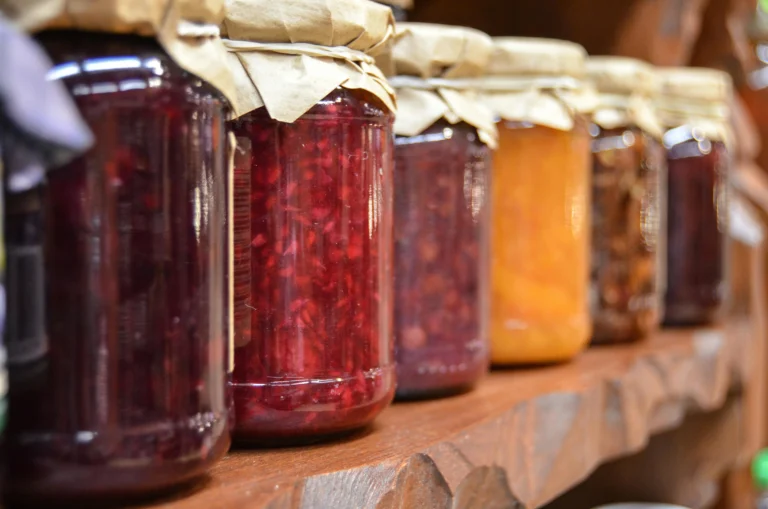What “One Year Food Storage” Really Means (and Why It Matters)
You’re building 365 days of real meals your household will eat. Not novelty buckets. Not mystery packets. Real staples that turn into weeknight dinners and familiar breakfasts.
Quick start: If you want a step-by-step pantry and homestead plan that’s simple to follow, see The Self-Sufficient Backyard. For old-school shelf-stable recipes and preservation methods that actually fill a pantry, browse The Lost Superfoods.
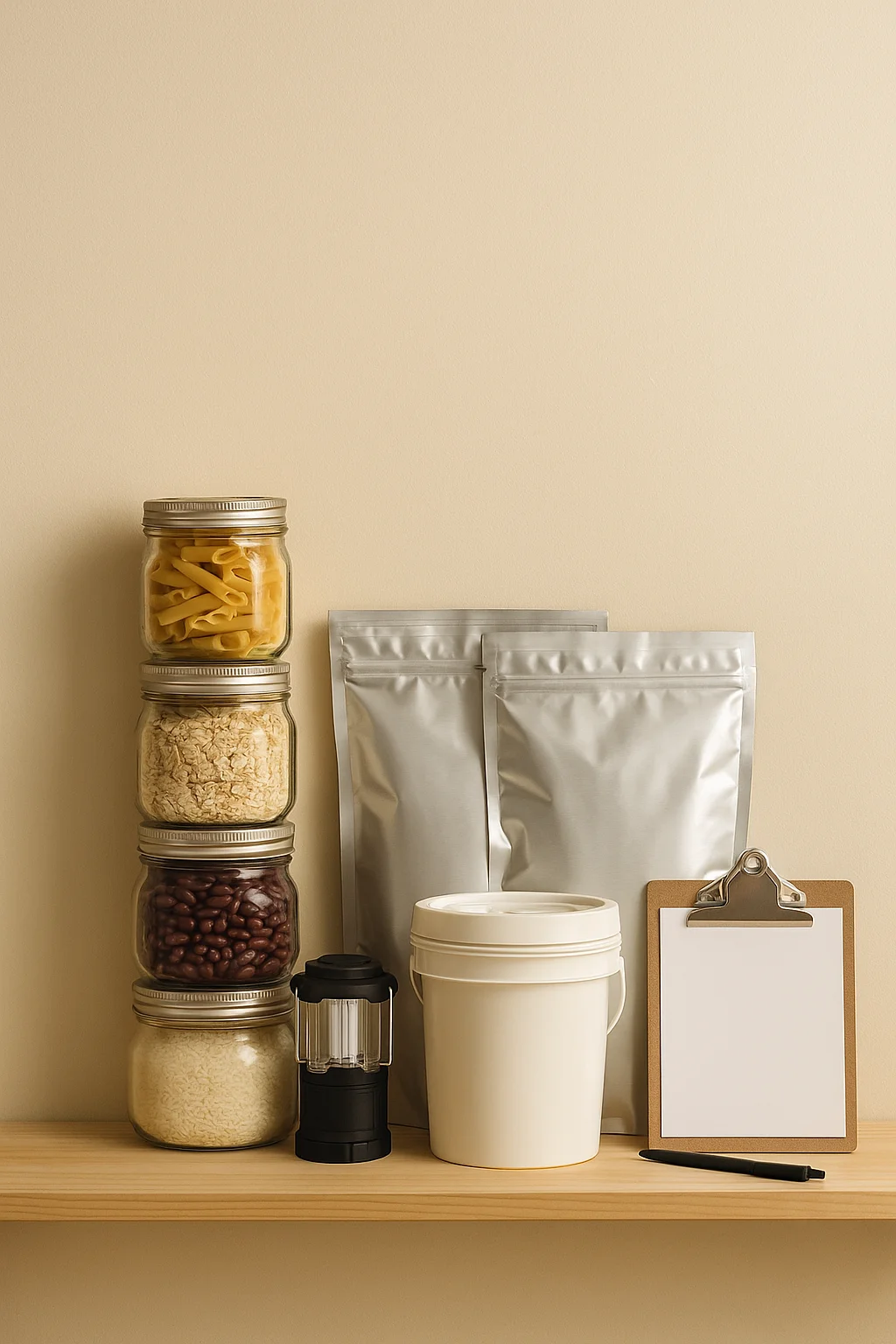
Why it matters to you
-
Smooth out price spikes and supply hiccups.
-
Cut last-minute store runs and takeaway.
-
Protect your time and energy during busy or stressful seasons.
-
Gain confident independence when the unexpected shows up.
Core principles
-
Store what you eat; eat what you store.
-
FIFO (First In, First Out): use the oldest items first and replace them with new stock.
-
Balance: calories, protein, fats, fiber, and flavor all count.
How Much Food Do You Need? (Your Quick Calculator)
Calorie Targets & Macro Balance
Start with a simple baseline and adjust for your household:
-
Adults: ~2,000 kcal/day (more if highly active, pregnant, or nursing; less if smaller or less active).
-
Per adult per year: ~730,000 kcal (2,000 × 365).
-
Macro guide:
-
Carbs/starches: 50–60% of calories (grains, rice, pasta, oats, potatoes)
-
Protein: 10–20% (beans, lentils, canned meats, dairy)
-
Fats: 20–30% (oils, nut butters, ghee)
-
You don’t need perfect nutrition at every meal; you need a pantry that supports balanced, tasty food you’ll actually cook.
Family Example (2 Adults + 2 Children)
Two adults at ~2,000 kcal/day and two children at ~1,500–1,800 kcal/day puts you around 7,200–7,600 kcal/day or roughly 2.6–2.8 million kcal/year. Translating that into bulk buys (rice, oats, beans, oil) plus canned and freezer items makes the goal doable.
Water Storage (Non-Negotiable)
-
Baseline: 1 gallon (3.8 L) per person per day for drinking and minimal sanitation.
-
Per person per year: 365 gallons.
-
Family of four: ~1,460 gallons.
Layer in filtration and purification tablets/unscented bleach as backups even if you store water.
The 5-Layer One-Year Pantry Strategy
Think in layers so you can build steadily and avoid gaps.
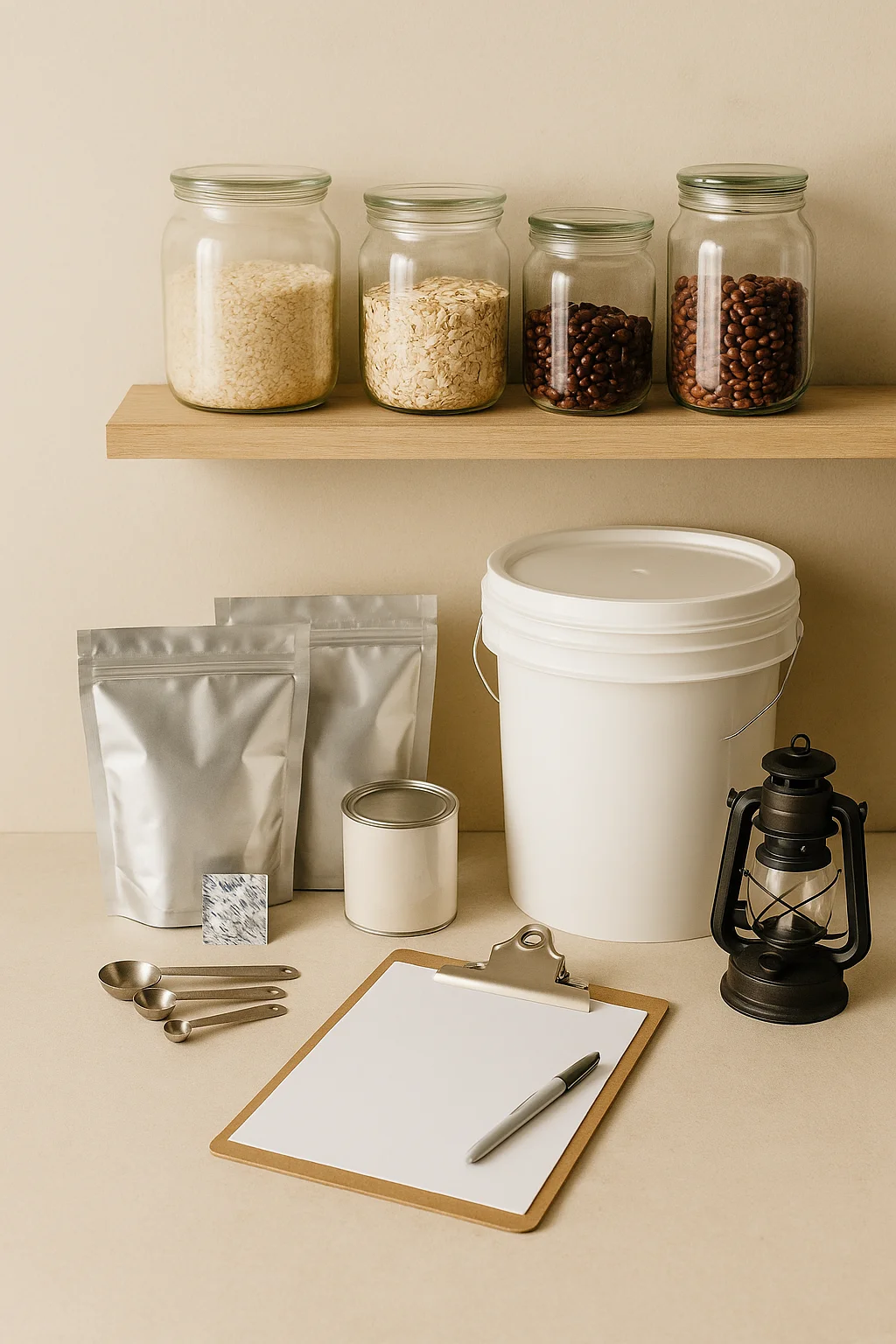
Layer 1: Everyday Pantry (30–60 Days)
This is what you already cook: rice, pasta, oats, canned tomatoes, tuna, beans, bouillon, spices, peanut butter, shelf-stable milk. You rotate this constantly because you use it every week.
Layer 2: Long-Term Dry Bulk (6–25+ Years if Packed Right)
The calorie backbone:
-
Grains: white rice, wheat (berries or flour), oats
-
Legumes: beans, lentils, peas
-
Fats: oil, ghee, shortening (rotate more often)
-
Sugar/honey, salt, powdered milk
How to pack: mylar bags + oxygen absorbers inside food-grade buckets; store cool, dark, and dry.
Pro tip: For time-tested storage recipes and calorie-dense staples that rotate cleanly, the guide in The Lost Superfoods pairs perfectly with a backyard layout from The Self-Sufficient Backyard so you can grow, store, and use food in one integrated plan.
Layer 3: Canned & Ready-to-Eat
Commercial cans (meats, vegetables, fruit, soups), broths, evaporated or shelf-stable milk. These bring speed, variety, and resilience when you’re tired or the power’s out.
Layer 4: Freezer Assets (3–12 Months)
Meat, butter, frozen veg and fruit, par-baked bread. Vacuum-seal if possible. Treat the freezer as a bonus, not a crutch, in case of outages.
Layer 5: Fresh + Preservation
Garden or market buys that you preserve with pressure canning (low-acid foods), water-bath canning (high-acid), dehydrating, and fermenting—always with tested methods. If you want a compact grow system to stack greens year-round, the AquaTower vertical garden makes great use of small spaces. For a simple backyard apothecary, start a bed from the Medicinal Garden Kit.
Storage Conditions & Containers
The “Three D’s”: Dark, Dry, Degrees (Cool)
-
Dark: no sunlight to degrade nutrients and fats.
-
Dry: low humidity to prevent clumping, mold, and corrosion.
-
Cool: aim for 50–70°F (10–21°C); cooler temps extend shelf life dramatically.
Packaging & Tools That Save Your Food (and your budget)
-
Mylar bags (5–7 mil) with oxygen absorbers matched to bag size.
-
Food-grade buckets (gamma lids are handy).
-
Glass jars for quick-use dry goods; #10 cans if available.
-
Markers + labels: date, weight, and contents on every container.
-
Sturdy shelving (anchor to studs if you’re in quake zones or have kids).
Budgeting the Build: From 30 Days to 12 Months
You don’t need to do this in a weekend. Build in predictable, affordable steps.
-
Month 1–2: Create a 30-day pantry of what you already eat.
-
Month 3–4: Expand to 60–90 days; add first buckets of rice/beans/oats.
-
Month 5–8: Round out oils, sugar, powdered milk; buy case lots of canned goods.
-
Month 9–12: Fill gaps (protein variety, spices, comfort foods); finalize water plan.
Money-smart moves
-
Track price per calorie on staples (rice, oats, flour, oil, beans).
-
Shop weekly sales and case discounts.
-
Choose durable storage once; it pays back for years.
What to Store (Quantities & Calories)
Use this as a baseline and tune it to your dietary needs, allergies, and preferences.
Starter Staples per Person (12 Months)
| Food | Suggested Quantity | Approx. Calories (Total) | Notes |
|---|---|---|---|
| White rice | 100 lb | ~165,000 kcal | Long shelf life in mylar + O₂ |
| Rolled oats | 40 lb | ~70,000 kcal | Breakfast, baking, granola |
| Wheat flour or wheat berries | 120 lb | ~204,000 kcal | Berries last longer; flour rotates faster |
| Dry beans (mixed) | 60 lb | ~98,000 kcal | Protein + fiber |
| Lentils | 30 lb | ~48,000 kcal | Faster to cook than beans |
| Sugar or honey | 60 lb | ~93,000 kcal | Energy + baking |
| Vegetable oil | 10 qt | ~76,000 kcal | Buy smaller bottles; rotate |
| Powdered milk | 16 lb | ~26,000 kcal | Protein, calcium, baking |
| Peanut butter | 24 lb | ~39,000 kcal | Kid-friendly calories |
| Pasta | 40 lb | ~68,000 kcal | Variety, quick meals |
| Canned meats | 24–48 cans | — | Rotate 12–24 months |
| Salt & spices | 8 lb + | — | Flavor + electrolytes |
Pantry add-ons that boost morale and nutrition
-
Canned tomatoes, tomato paste, broth, canned veg/fruit.
-
Vinegar, soy sauce, mustard, hot sauce, cocoa, baking powder/soda, yeast.
-
Dried fruit, nuts/seeds, multivitamins (optional).
Safety First: Food Safety & Home Canning
-
Low-acid foods (plain vegetables, meats, beans, most soups) require pressure canning using current, tested recipes and altitude adjustments.
-
High-acid foods (jams, jellies, pickles, acidified tomatoes) are suited to water-bath canning.
-
Inspect commercial and home-canned goods routinely: bulging, leaking, rust, spurting, or off-odors = discard without tasting.
-
Label jars with contents + date. When unsure, throw it out.
Menu Planning & Rotation You’ll Actually Do
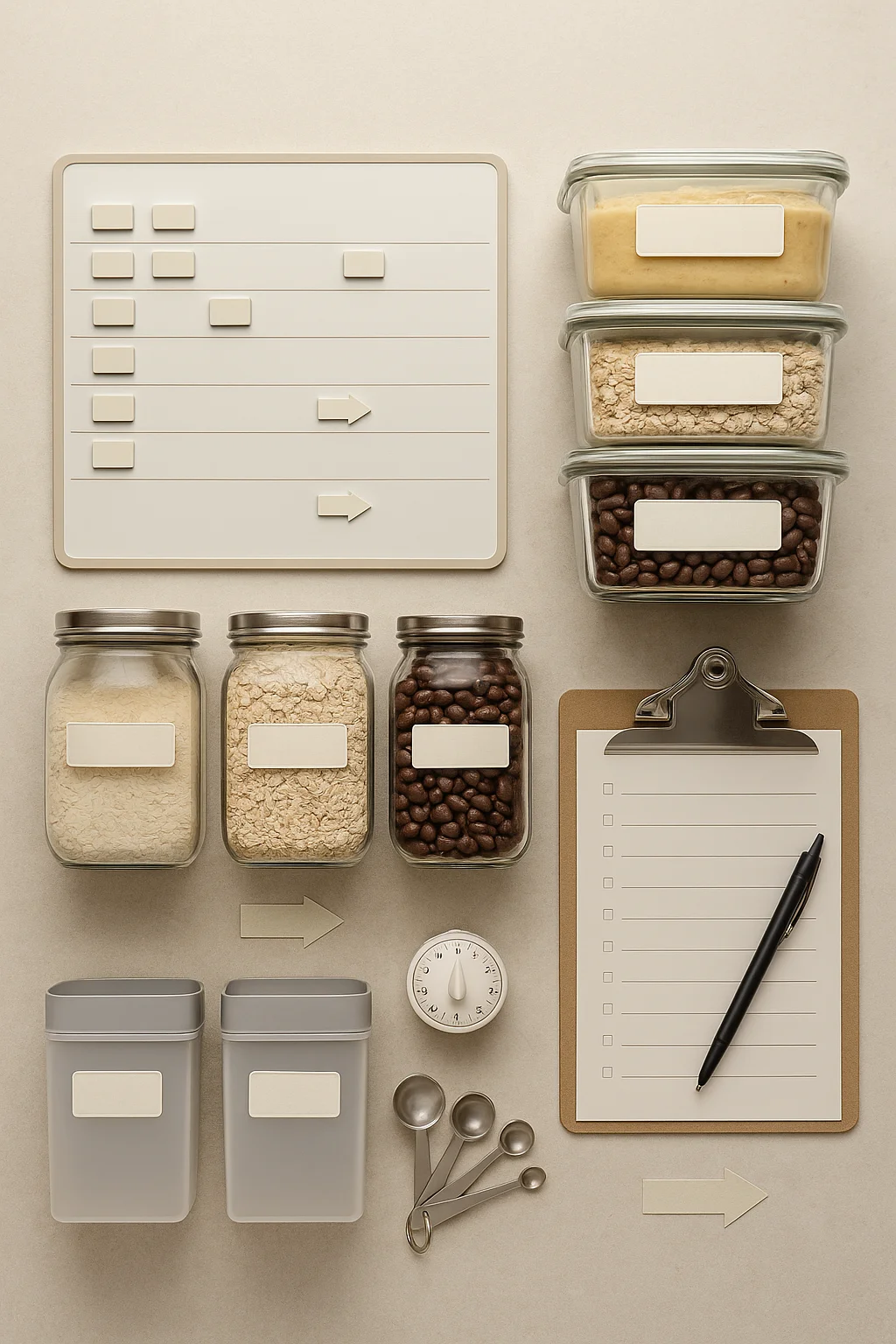
Build 10–15 “Core Meals”
Choose dinners you already love and stock to make each 6–12 times. Cook a pantry meal once or twice weekly and replace what you used next time you shop. That’s FIFO in action without thinking about it.
Pantry-Friendly Recipes (Ingredient Tables)
Quantities serve typical families; scale as needed. Add fresh produce or freezer items when available.
Hearty Lentil & Rice Pilaf (serves ~6)
| Ingredient | Pantry Form | Quantity |
|---|---|---|
| Lentils | Dry | 2 cups |
| Rice (long-grain) | Dry | 2 cups |
| Broth | Bouillon + water | 4 cups |
| Onion | Dehydrated flakes | 2 tbsp |
| Garlic | Powder | 1 tsp |
| Oil | Vegetable oil | 2 tbsp |
| Spices | Cumin, paprika, salt, pepper | To taste |
Method tip: Toast spices in oil, add rice and lentils, stir, then add broth and simmer until tender. Finish with a splash of vinegar or lemon if you have it.
Black Bean Pantry Chili (serves ~6)
| Ingredient | Pantry Form | Quantity |
|---|---|---|
| Black beans | 3 cans (or 4 cups cooked) | ~45 oz |
| Diced tomatoes | Canned | 2 cans (14–15 oz) |
| Tomato paste | Canned | 1 can (6 oz) |
| Corn | Canned | 1 can |
| Chili seasoning | Dry blend | 2–3 tbsp |
| Oil | Pantry | 1–2 tbsp |
| Salt & pepper | Pantry | To taste |
Method tip: Sauté spices in oil for 30 seconds to bloom flavor, then add tomatoes, paste, beans, and corn; simmer 20–30 minutes.
Tuna-Tomato Weeknight Pasta (serves ~4–5)
| Ingredient | Pantry Form | Quantity |
|---|---|---|
| Pasta | Dry | 1 lb |
| Tuna in oil | Canned | 2 cans (5 oz) |
| Crushed tomatoes | Canned | 1 can (28 oz) |
| Garlic & onion | Powder/flakes | 1 tsp / 1 tbsp |
| Herbs | Dried basil/oregano | 1–2 tsp |
| Oil | Pantry | 1 tbsp |
| Salt & pepper | Pantry | To taste |
Method tip: Simmer the sauce while the pasta cooks. Fold tuna in at the end to keep texture.
Oats & Peanut Butter Power Bowls (serves ~4)
| Ingredient | Pantry Form | Quantity |
|---|---|---|
| Rolled oats | Dry | 2 cups |
| Powdered milk | Reconstituted | 3 cups |
| Peanut butter | Shelf-stable | 4 tbsp |
| Sugar or honey | Pantry | 2–3 tbsp |
| Cinnamon | Ground | 1 tsp |
| Raisins | Dried fruit | ½ cup |
Method tip: Cook oats in milk, stir in peanut butter and sweetener, top with raisins and cinnamon.
Special Diets & Family Preferences
-
Gluten-free: Emphasize rice, corn, certified GF oats, quinoa, potatoes; check labels on canned soups and bouillon.
-
Dairy-free: Use shelf-stable plant milks, canned coconut milk, and nut/seed butters for creaminess.
-
Vegetarian/Vegan: Boost legumes, lentils, textured vegetable protein (TVP); consider B12-fortified products if relevant.
-
Kids & Seniors: Aim for softer textures, easy-open cans, lower-sodium options, and familiar flavors.
Organization That Makes Rotation Automatic
Keep an Inventory (Paper or Spreadsheet)
Track Item, Quantity, Unit, Calories, Packed On, Best By, Location, Notes. Review quickly each week; do a deeper audit each quarter.
Labeling & Shelf Layout
-
Label the front/top with big, bold dates.
-
Put oldest in front, newest in back.
-
Group by category (grains, canned meals, proteins, baking, oils, spices) so you can see gaps at a glance.
Rotation Rhythm
-
Rule of two: when you use one, buy two.
-
Weekly 10-minute check: note anything getting low or nearing its date and plan it into next week’s meals.
-
Seasonal re-balance: spices fade faster; oils age; kids’ tastes change—tweak accordingly.
Common Mistakes (and Easy Fixes)
-
Buying foods you don’t eat.
Fix: Build around your 10–15 core meals first. -
Under-storing fats and flavor.
Fix: Stock oils, nut butters, spices, vinegar, shelf-stable sauces. -
Storing in hot garages/attics.
Fix: Move to cool interior closets or under-bed bins. -
Skipping labels and logs.
Fix: Label everything on day one and keep a simple inventory. -
No water plan.
Fix: Store the baseline and add filtration/purification backups.
Tools & Gear (Must-Haves vs Nice-to-Haves)
Must-Haves
-
Mylar bags, oxygen absorbers, food-grade buckets (gamma lids help).
-
Can opener, markers, labels.
-
Basic water filter and purification tablets/unscented bleach.
Nice-to-Haves
-
Vacuum sealer (and jar attachments).
-
Can rotator racks; heavy-duty shelving (anchored).
-
Grain mill (if storing wheat berries).
-
Pressure canner for low-acid; water-bath canner for high-acid.
Your 12-Month Build Plan (Quick Roadmap)
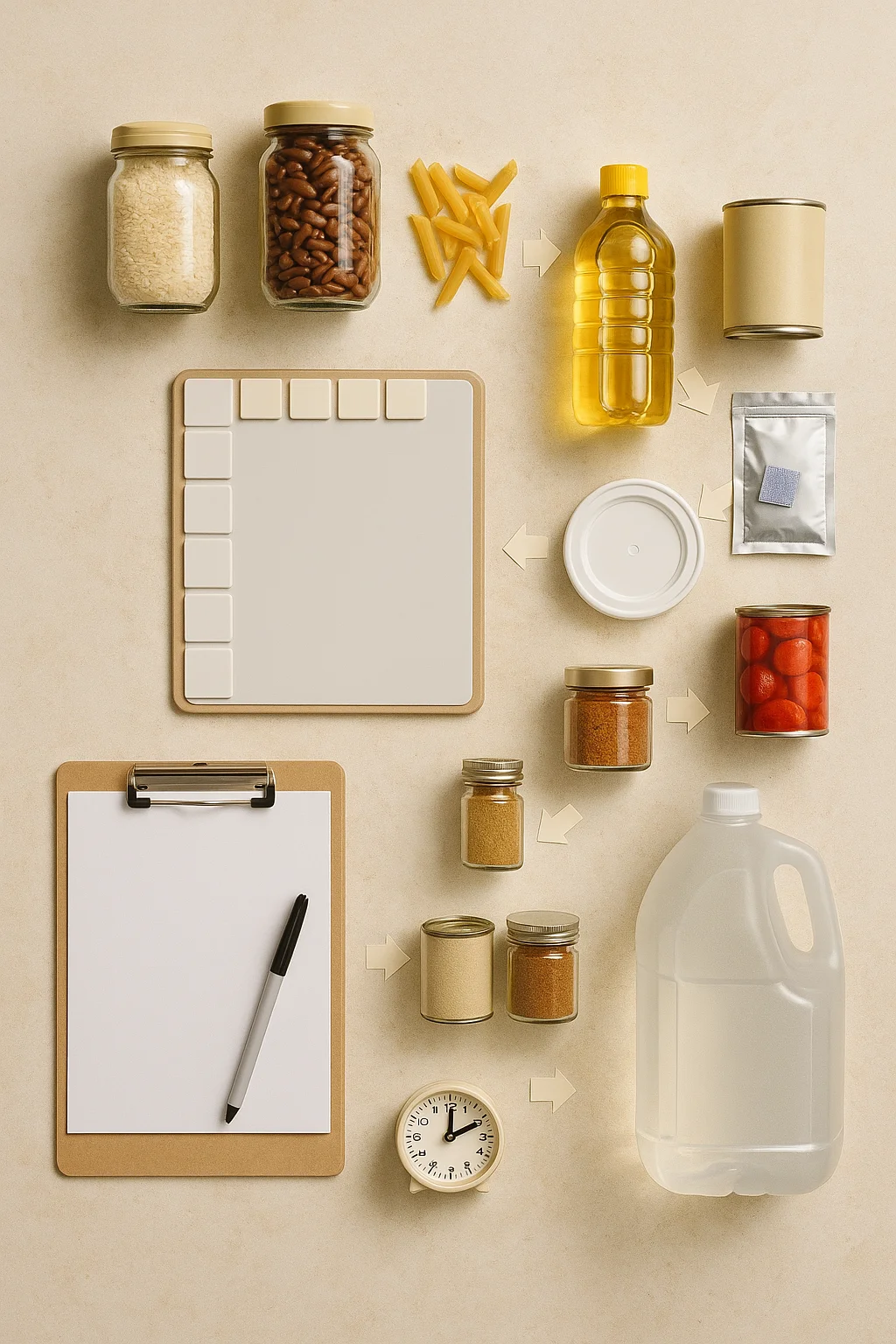
Months 1–3: Build a 90-Day Pantry
Double up on weeknight staples; start water storage; test 4 pantry recipes and write down your household’s winners.
Months 4–6: Bulk Staples + Freezer
Buy buckets, mylar, and O₂ absorbers; add oils, sugar, beans, rice, oats. Vacuum-seal meats and butter for the freezer.
Months 7–9: Variety + Spices
Stock case lots of tomatoes, veg, fruit, and canned meats; expand your spice shelf; refine your inventory sheet.
Months 10–12: Fill Gaps & Stress-Test
Top up calories, protein variety, and comfort foods; finalize one-year water. Run a 7-day “pantry-only” drill and note anything missing.
FAQs About One Year Food Storage
How much does one year food storage cost?
Costs vary by foods and packaging. A frugal one year food storage built from rice, oats, beans, flour, oil, and canned goods can range from low to mid budget per person, while premium freeze-dried kits push the total much higher. Build one year food storage in layers to smooth expenses.
What belongs in a basic one year food storage list?
Grains (rice, wheat/flour, oats), legumes (beans, lentils), fats (vegetable oil, ghee), sugar or honey, salt, powdered milk, pasta, canned proteins, canned tomatoes/veg/fruit, broths, and spices. Round out one year food storage with comfort items you actually eat.
How do I calculate quantities for one year food storage?
Plan calories first (about 730,000 kcal per adult/year). Convert calories to staple amounts, then add variety. For families, multiply and adjust for kids’ needs. A simple sheet makes one year food storage math fast and consistent.
Do I need water as part of one year food storage?
Yes. Water is integral to one year food storage. Aim for at least 1 gallon per person per day (more in hot climates), plus filters and purification backups.
What containers are best for long-term one year food storage?
For dry goods, use mylar bags with oxygen absorbers inside food-grade buckets (gamma lids help). Canned items stay in their original cans on sturdy shelves. This combo protects one year food storage from light, oxygen, moisture, and pests.
How should I store one year food storage for maximum shelf life?
Keep it cool, dark, and dry—ideally 10–21°C (50–70°F). Label and date everything. Good conditions can extend one year food storage quality by years.
How do I rotate one year food storage without waste?
Cook from your pantry weekly and replace items on your next shop. Place older stock in front (FIFO). A quick inventory check makes one year food storage rotation automatic.
Is a freezer required for one year food storage?
No. Design one year food storage to be shelf-stable first. Treat the freezer as a bonus layer for variety (meat, butter, veg/fruit) in case of outages.
Can I home-can foods for one year food storage?
Yes—with tested methods. Low-acid foods (meats, beans, plain veg) require pressure canning; high-acid items (jams, pickles, acidified tomatoes) use water-bath canning. Safe canning protects your one year food storage.
What are common mistakes with one year food storage?
Buying foods you don’t eat, ignoring fats/flavor, storing in hot spaces, skipping labels, and forgetting water. Avoid these to keep one year food storage practical and tasty.
How do special diets fit into one year food storage?
Customize. For gluten-free, emphasize rice, corn, certified GF oats. For dairy-free, use plant milks and coconut milk. Vegetarian/vegan one year food storage leans on legumes, lentils, TVP, nut/seed butters.
How often should I audit one year food storage?
Do a 10-minute weekly glance and a deeper check quarterly. Top up gaps, rotate nearing-date items into meals, and update the log so one year food storage stays accurate.
What spices and condiments help one year food storage feel “normal”?
Salt, pepper, garlic/onion powder, chili, cumin, paprika, Italian blend, soy sauce, vinegar, mustard, hot sauce, cocoa. Small flavor adds make one year food storage meals satisfying.
How do I start one year food storage on a tight budget?
Build a 30-day layer of what you already eat, then repeat to reach 60, 90, and 365 days. Track price per calorie, buy case lots on sale, and add storage gear once—your one year food storage will grow consistently.
Can I include ready-to-eat items in one year food storage?
Absolutely. Canned soups, meats, fruit, and shelf-stable milk provide fast meals during busy days or power cuts, making one year food storage more resilient and convenient.
Confidence on a Shelf
A solid one year food storage plan isn’t panic-buying; it’s calm planning. You store what you eat, protect it with smart packaging, and rotate it without thinking. Start with one shelf, one habit, and one extra can at a time. A year from now, you won’t just have a full pantry—you’ll have freedom.
Your move today: print (or duplicate) a simple inventory sheet, pick four pantry recipes from this article, and stock a 30-day layer this week. Want help tailoring quantities to your household’s age, activity, and diet? Ask for a custom calorie-and-quantity worksheet, and I’ll build a plug-and-play plan you can start immediately.

